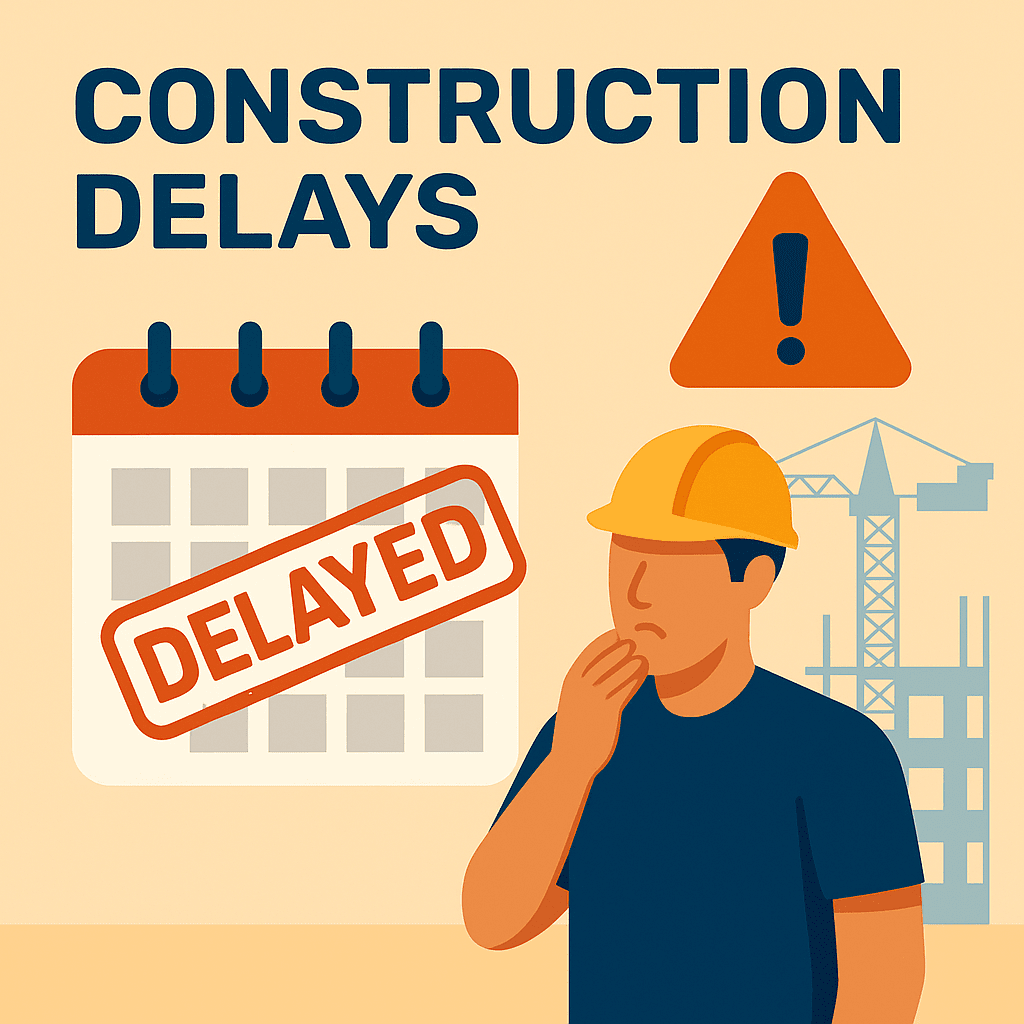In the construction world, time really is money. For homeowners and builders alike, few things cause more frustration — and cost more in the long run — than unexpected construction delays. A single missed delivery, a late subcontractor, or a last-minute design change can throw an entire schedule off track, leading to budget overruns, legal disputes, and damaged reputations.
The good news? Many of these delays are predictable — and preventable. By understanding the most common causes of construction delays and taking proactive steps, you can keep your project on schedule and your clients happy.

Section 1: Poor Planning and Scheduling
Effective planning should also account for potential external delays, such as weather conditions or supply chain disruptions. For instance, if a builder is aware that certain materials require longer lead times due to supplier constraints, this information should be factored into the initial project timeline.
At BuilderExpert, we’ve seen firsthand how proper planning, accurate estimating, and effective project management can drastically reduce the risk of delays. Whether you’re a builder looking to streamline operations or a homeowner aiming for a smooth build, knowing the risks upfront is your best defence.
In this guide, we’ll break down the main culprits behind project setbacks, explain how to prevent them, and share practical tools that make staying on schedule not just possible — but predictable.
Section 1: Poor Planning and Scheduling
It’s no surprise that poor planning is the leading cause of construction delays. When a project starts without a detailed schedule, clearly assigned responsibilities, and agreed milestones, small issues quickly snowball into major disruptions.
Common planning mistakes include:
Conclusion: Understanding Construction Delays
In conclusion, construction delays can have significant ramifications on both budget and project timelines. By understanding the various factors that contribute to these delays, such as poor planning and scheduling, builders and homeowners can take proactive measures to mitigate risks. Through effective communication, structured planning, and the use of technology, it is possible to keep construction projects on track and avoid the pitfalls that lead to delays. Ultimately, maintaining a strong focus on reducing the likelihood of construction delays not only benefits project completion but also enhances the overall satisfaction of clients and stakeholders.
In summary, the importance of proper planning cannot be overstated. By investing time and resources into developing a comprehensive project plan, builders can effectively mitigate the risks associated with construction delays.
- Vague or incomplete timelines
- Missing lead times for ordering materials
- Lack of coordination between trades
- Overlapping work that causes site congestion
The solution? Start with a clear, realistic schedule that factors in all tasks, dependencies, and potential bottlenecks. Using tools like the Detailed Estimate feature ensures you have a solid financial plan to match your timeline, while the Construction Project Workflow guide helps break down each phase logically.
Builders who also incorporate a Bill of Quantity (BoQ) can track materials and resources more accurately, preventing last-minute scrambles that halt progress.
By combining clear planning with detailed resource tracking, you can significantly reduce the risk of avoidable construction delays right from day one.
Section 2: Material Shortages and Supply Chain Issues
In recent years, UK builders have faced unprecedented supply chain disruptions. From Brexit-related import challenges to global manufacturing slowdowns, getting materials on time has become one of the biggest contributors to construction delays. Even a single missing component — like a set of windows or a boiler — can bring an entire project to a standstill.
Common reasons for shortages include:
- Increased demand during peak building seasons
- International shipping delays
- Factory production slowdowns or strikes
- Special-order materials with long lead times
To avoid these problems, order materials as early as possible and work closely with suppliers to confirm availability before starting each phase. Using a system like Real-Time Pricing allows builders to check up-to-date prices and availability before committing to orders, reducing the risk of last-minute surprises.
For projects requiring complex materials or custom finishes, including them early in your Construction Estimate Best Practices process ensures suppliers have adequate time to deliver.
Ultimately, proactive procurement and real-time information are the best defence against material-related construction delays.
Section 3: Weather and Site Conditions
While you can plan for many risks in construction, the British weather remains an unpredictable factor. Heavy rain, snow, high winds, or freezing temperatures can all halt work, particularly on tasks like roofing, foundations, and exterior finishes. Even when the forecast looks clear, sudden storms can force contractors to pause operations for safety reasons.
In addition to weather, site conditions play a huge role. Waterlogged soil, unexpected ground obstructions, or unstable foundations can require extra preparation before construction can proceed — all of which extend the schedule.
That’s why every builder should factor in seasonal considerations when creating a schedule. The Construction Project Timeline UK guide is an excellent reference for understanding how weather patterns impact different stages of a build. By building in contingency time for seasonal slowdowns, you can set realistic deadlines and avoid disappointing clients.
Also, consider conducting thorough site assessments before breaking ground. This allows you to anticipate and address potential ground issues before they cause construction delays.
Section 4: Changes in Design and Scope
One of the most common — and costly — causes of construction delays comes from changes requested after work has already begun. Whether it’s moving a wall, upgrading finishes, or adding an entirely new feature, even small adjustments can create a ripple effect through the schedule.
When changes are made mid-project:
- Existing work may need to be dismantled or re-done
- New materials must be ordered, often with lead times
- Trades may need to be rescheduled, causing gaps in productivity
Preventing these issues starts with clear communication and thorough planning before work begins. Homeowners should be encouraged to ask the right questions from the outset — the Questions to Ask a Builder guide is a valuable resource here.
For builders, the Managing Client Expectations framework ensures everyone understands what’s included, what isn’t, and what will happen if changes are requested later. By having change request procedures in place, you can minimise disruption and keep the project as close to the original timeline as possible.
Ultimately, locked-in designs and a clear scope of work are among the best protections against unnecessary construction delays.
Section 5: Labour Shortages and Subcontractor Delays
Even the most carefully planned project can grind to a halt if there aren’t enough skilled hands on site. Labour shortages have been a growing challenge in the UK construction sector, driven by factors like Brexit, an ageing workforce, and increased demand for building projects.
Subcontractor delays — whether due to overbooking, illness, or poor coordination — can also leave critical tasks unfinished, creating a chain reaction of setbacks.
The best prevention is to work with a well-structured and reliable team from the start. The Construction Team Roles guide outlines the key people every project needs, while tools like the On-Site Estimate service help builders accurately schedule and allocate labour resources.
Maintaining good relationships with trusted subcontractors, setting clear expectations, and having backup trades ready can also significantly reduce the risk of labour-related construction delays.
Section 6: Legal and Regulatory Delays
Few things stall a project faster than legal or regulatory complications. In the UK, this can include everything from delayed planning permissions to building regulation failures and contractual disputes. If the required approvals aren’t in place or inspection results are unsatisfactory, work may be halted until the issues are resolved.
A common mistake is starting construction before all permits and documents are finalised. This can lead to stop-work orders, legal penalties, and months of lost time.
Builders can avoid many of these pitfalls by ensuring contracts are watertight and approvals are secured before any work begins. The Construction Contract Mistakes guide outlines the most common legal errors and how to avoid them, while Fixed Price vs Cost Plus Contracts explains how choosing the right contract type can prevent future disputes.
Ultimately, proactive legal compliance is one of the most effective ways to keep a project running smoothly and avoid avoidable construction delays.
Section 7: How to Avoid Construction Delays — Best Practices
While no project is immune to setbacks, following proven best practices can drastically reduce the likelihood of construction delays. Successful builders and project managers often share these strategies:
- Start with accurate estimates – Tools like the Detailed Estimate and Basic Estimate services give a clear financial foundation that matches the planned schedule.
- Use real-time data – Real-Time Pricing ensures costs and material availability are up-to-date before ordering.
- Plan with precision – A Construction Project Workflow helps structure every phase logically, with clear dependencies and deadlines.
- Lock in designs early – Avoid mid-build changes by finalising plans and confirming specifications before work starts.
- Maintain open communication – Weekly progress updates and written records prevent misunderstandings that lead to delays.
- Build a dependable team – Refer to the Construction Team Roles guide to ensure all key roles are covered.
- Factor in contingencies – Add buffer time for weather, supply issues, and other common risks.
By combining these best practices with consistent oversight and quick decision-making, both builders and homeowners can keep their projects on track — even when unexpected challenges arise.
Summary
Construction delays may be a reality in the building industry, but they don’t have to derail your project. By understanding the most common causes — from poor planning and material shortages to weather, labour issues, and legal obstacles — you can take proactive steps to reduce the risk.
Using tools like BuilderExpert gives you access to accurate estimates, real-time material data, and structured workflows that help you plan, coordinate, and deliver on schedule. Whether you’re a builder aiming to protect your reputation or a homeowner wanting peace of mind, the right preparation makes all the difference.
You can also connect with us on social media for more tips, industry updates, and practical advice to help you manage your projects successfully. Follow us on Facebook, LinkedIn, and YouTube to stay informed and ahead in the construction industry.

